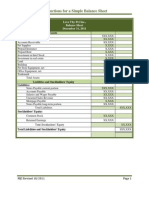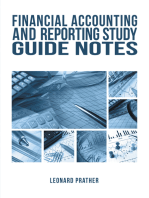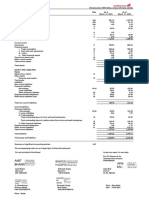Balance Sheet
Balance Sheet
Uploaded by
Kiran KiranCopyright:
Available Formats
Balance Sheet
Balance Sheet
Uploaded by
Kiran KiranOriginal Description:
Copyright
Available Formats
Share this document
Did you find this document useful?
Is this content inappropriate?
Copyright:
Available Formats
Balance Sheet
Balance Sheet
Uploaded by
Kiran KiranCopyright:
Available Formats
Example Company Balance Sheet December 31, 2010 ASSETS Current Assets Cash Petty Cash Temporary Investments
Accounts Receivable - net Inventory Supplies Prepaid Insurance Total Current Assets Investments Property, Plant & Equipment Land Land Improvements Buildings Equipment Less: Accum Depreciation Prop, Plant & Equip - net Intangible Assets Goodwill Trade Names Total Intangible Assets Other Assets Total Assets LIABILITIES Current Liabilities Notes Payable Accounts Payable Wages Payable Interest Payable Taxes Payable Warranty Liability Unearned Revenues Total Current Liabilities
$ 2,100 100 10,000 40,500 31,000 3,800 1,500 89,000
$ 5,000 35,900 8,500 2,900 6,100 1,100 1,500 61,000 20,000 400,000 420,000
36,000 Long-term Liabilities Notes Payable Bonds Payable 5,500 Total Long-term Liabilities 6,500 180,000 201,000 Total Liabilities (56,000) 337,000 STOCKHOLDERS' EQUITY 105,000 Common Stock 200,000 Retained Earnings 305,000 Less: Treasury Stock Total Stockholders' Equity 3,000 $770,000 Total Liab. & Stockholders' Equity
481,000
110,000 229,000 (50,000) 289,000 $770,000
Assets are things that the company owns. They are the resources of the company that have been acquired through transactions, and have future economic value that can be measured and expressed in dollars. Assets also include costs paid in advance that have not yet expired, such as prepaid advertising, prepaid insurance, prepaid legal fees, and
prepaid rent. (For a discussion of prepaid expenses go to Explanation of Adjusting Entries.)
Examples of asset accounts that are reported on a company's balance sheet include:
Cash Petty Cash Temporary Investments Accounts Receivable Inventory Supplies Prepaid Insurance Land Land Improvements Buildings Equipment Goodwill Bond Issue Costs Etc.
Notes Payable Accounts Payable Salaries Payable Wages Payable Interest Payable Other Accrued Expenses Payable Income Taxes Payable Customer Deposits Warranty Liability Lawsuits Payable Unearned Revenues Bonds Payable Etc.
The Balance Sheet A balance sheet shows the financial resources. that a company has at a point in time and where they came from. It is an instant photograph that displays the company's financial station at the end of a business month, quarter or year. The organization of a balance sheet reflects this basic arrangement: assets equal debts plus equity The chart of accounts is a listing of the accounts that are reflected in the financial statements; Assets are often listed in the order of their liquidity which means how easy it would be to convert each asset into cash. Assets are divided into three categories: Current Assets, Fixed Assets, and Other. Assets. Current assets will likely be turned into cash or converted into a(n) expense. within a year Liabilities are debts or others. stemming from goods or services received by the company. Fixed assets are saleable, but are not expected to be converted to cash in the final. course of business If the assets of a company are greater than its liabilities, then the equity of the business is the positive difference. between the two numbers
Income Statements The statement of income and expenses reports the company's income and expenses for the time period: it is also called a profit-and-loss statement. Correct answer: (c) profit The first item on the statement is the total amount of sales of products or services; this is often referred to as gross sales. Correct answer: (a) gross The main deduction from this revenue is called cost of sales, the amount of money the company spent to produce the same goods or services. Correct answer: (a) cost The next deduction is operating expenses for example, administrative salaries and research costs, which do not vary directly with production. Correct answer: (b) operating Depreciation expenses the wear and tear on assets like machinery, equipment and furnishings. Correct answer: (d) tear The depreciation charge for using these assets during the accounting period is a function of their original cost. Correct answer: (d) function Interest income is the money that the company earns by keeping its cash in savings accounts, term deposits, etc. Correct answer: (c) Interest Finally, income tax is deducted. Correct answer: (c) income The final entry is the bottom line, which represents net earnings of the company during the accounting period. Correct answer: (d) bottom
Additionally, EPS indicates how much shareholders would receive if the company distributed all of its net earnings as dividends. Correct answer: (a) EPS Cost Accounting Management or cost accounting systems are part of a company's information system and are used for tracking costs and allocations to judge operational efficiency. This is an internal accounting system, rather than one for outside reporting. There are no fixed rules governing how a company should keep track of cash flows for cost accounting purposes. Capital budgeting is a form of forecasted cost accounting for long-term projects or expenditures. Cost accounting applications are major financial drivers in everyday corporate decisionmaking. Cost accounting is important for estimating the profitability of current and future activities. When good cost accounting procedures are implemented, the company may find out that they have been producing a non-profitable product or service. Cost accounting motivates managers toward company goals. It also measures the performance of managers and departments in the company. Variable costs change in proportion to the level of production activity, while fixed costs remain unchanged. Accountants Most accounting positions require a bachelor's degree in accounting or a related field or an equivalent combination of education and experience. Many companies want graduates with a master's degree in accounting, or a master's degree in business administration with a concentration in accounting. Some schools offer students a chance for hands-on experience with part-time internship programs in accounting or commercial firms.
Accountants help make sure that a firm is run efficiently, that its records are maintained accurately, and that its taxes are paid properly and in a timely manner. Nowadays, accountants are broadening the services they offer with budget analysis, investment planning, and IT consulting. Public accountants, many of whom are CPAs, generally have their own companies or work for major accounting firms. Some accountants specialize in forensic accounting investigating white-collar crimes such as securities fraud and embezzlement. Many work closely with law enforcement officers and lawyers during investigations and often appear as expert witnesses during trials. Management accountants record and analyze the financial information of the firms in which they are employed. Government accountants work in the public sector, maintaining and monitoring the recordkeeping of government departments and agencies.
Step 1: Give a brief introduction about yourself: For example: My name is Peter. I graduated from XYZ University with bachelor degree in Sales. After 5 years working as a Sales Manager, I have well experienced in training, mentoring and motivating other sales personnel to achieve the goals of the Company.
You might also like
- Chart of Accounts For Small Business Template V 1.0Document3 pagesChart of Accounts For Small Business Template V 1.0molateam2100% (2)
- Financials GlossaryDocument248 pagesFinancials GlossarySaif Al MutairiNo ratings yet
- Chart of AccountsDocument22 pagesChart of AccountsaddyNo ratings yet
- Bueno MarketingDocument31 pagesBueno MarketingEnges Formula100% (1)
- Bank Reconciliation StatementDocument32 pagesBank Reconciliation StatementMuhammad Arslan100% (2)
- Ap RmycDocument16 pagesAp RmycJoseph Bayo BasanNo ratings yet
- Intermediate Accounting 2: a QuickStudy Digital Reference GuideFrom EverandIntermediate Accounting 2: a QuickStudy Digital Reference GuideNo ratings yet
- Balance SheetDocument90 pagesBalance SheetRashed100% (1)
- Income Statement: (Company Name)Document3 pagesIncome Statement: (Company Name)Ranu JanuarNo ratings yet
- Balance Sheet Income StatementDocument50 pagesBalance Sheet Income Statementgurbaxeesh50% (2)
- Computerised Accounting Practice Set Using MYOB AccountRight - Advanced Level: Australian EditionFrom EverandComputerised Accounting Practice Set Using MYOB AccountRight - Advanced Level: Australian EditionNo ratings yet
- Accounting DocumentsDocument7 pagesAccounting DocumentsAryan Sofia FranciscoNo ratings yet
- Chapter 1 Review of The Accounting Cycle of A Service and Merchandising BusinessDocument17 pagesChapter 1 Review of The Accounting Cycle of A Service and Merchandising Businesstim c50% (2)
- EXERCISE ON ADJUSTING ENTRIES - Corrected VersionDocument2 pagesEXERCISE ON ADJUSTING ENTRIES - Corrected VersionRoy BonitezNo ratings yet
- Computerised Accounting Practice Set Using MYOB AccountRight - Entry Level: Australian EditionFrom EverandComputerised Accounting Practice Set Using MYOB AccountRight - Entry Level: Australian EditionNo ratings yet
- Answer Key To Related Multiple Choice Theory Questions:: D. None of TheseDocument81 pagesAnswer Key To Related Multiple Choice Theory Questions:: D. None of TheseThird YearNo ratings yet
- Hul Ratio AnalysisDocument14 pagesHul Ratio Analysisvviek100% (1)
- 1.0 Group of Company 1.1 1.2 1.3 1.4 1.5: 1 Enterprise StructureDocument52 pages1.0 Group of Company 1.1 1.2 1.3 1.4 1.5: 1 Enterprise StructureMd Mukul HossainNo ratings yet
- Balance Sheet BasicsDocument12 pagesBalance Sheet Basicsapi-3741610100% (3)
- Income StatementDocument2 pagesIncome Statementapi-383676260% (5)
- Balance Sheet VerticalDocument22 pagesBalance Sheet VerticalberettiNo ratings yet
- Bank Reconciliation StatementDocument6 pagesBank Reconciliation Statementamnatariqshah100% (1)
- Control AccountsDocument22 pagesControl AccountsLorato Tunah Mokibito100% (2)
- Cash Flow TutorialDocument6 pagesCash Flow TutorialEric Chambers100% (1)
- Single Entry System and Incomplete Records NotesDocument5 pagesSingle Entry System and Incomplete Records NotesKristen Shaw100% (5)
- Cash Flow StatementDocument6 pagesCash Flow StatementAizia Sarceda Guzman80% (5)
- Accounting EquationDocument55 pagesAccounting EquationRahul VermaNo ratings yet
- Income StatementDocument19 pagesIncome StatementiPakistan75% (4)
- Basic Instructions For A Simple Balance SheetDocument3 pagesBasic Instructions For A Simple Balance SheetMary100% (9)
- Accounting Journal Entries With Business TransactionsDocument7 pagesAccounting Journal Entries With Business TransactionsMhel DemabogteNo ratings yet
- Local Media8011400976913649007Document16 pagesLocal Media8011400976913649007Ivan dela CruzNo ratings yet
- Accounting-Adjusting Journal EntriesDocument27 pagesAccounting-Adjusting Journal EntriesMary92% (26)
- Financial Statements and Ratio AnalysisDocument26 pagesFinancial Statements and Ratio Analysismary jean giananNo ratings yet
- Income StatementDocument26 pagesIncome StatementRashad MallakNo ratings yet
- Journal EntriesDocument2 pagesJournal EntriesNafis Hasan50% (2)
- Principal of Accounting: Topic: Cash BookDocument6 pagesPrincipal of Accounting: Topic: Cash BooksajidNo ratings yet
- Financial StatementsDocument20 pagesFinancial StatementsOmnath Bihari100% (1)
- 3 Income Statement ExamplesDocument3 pages3 Income Statement Examplesapi-299265916100% (1)
- Libby Financial Accounting Chapter14Document7 pagesLibby Financial Accounting Chapter14Jie Bo TiNo ratings yet
- Balance SheetDocument7 pagesBalance Sheetapi-27014089100% (2)
- Statement of Cash FlowsDocument16 pagesStatement of Cash FlowsWeng Torres AllonNo ratings yet
- Chapter 4 Accruals and PrepaymentsDocument12 pagesChapter 4 Accruals and PrepaymentsNgoni Mukuku100% (2)
- Profit & Loss StatementDocument1 pageProfit & Loss StatementNabila Ayuningtias100% (2)
- Review Materials: Prepared By: Junior Philippine Institute of Accountants UC-Banilad Chapter F.Y. 2019-2020Document20 pagesReview Materials: Prepared By: Junior Philippine Institute of Accountants UC-Banilad Chapter F.Y. 2019-2020AB Cloyd100% (1)
- Accounts (1) FinalDocument28 pagesAccounts (1) FinalManan MullickNo ratings yet
- General LedgerDocument9 pagesGeneral Ledgerananth-jNo ratings yet
- 2021 Audited Financial Statements - CompressedDocument27 pages2021 Audited Financial Statements - CompressedBernewsAdminNo ratings yet
- Chart of Accounts: Current AssetsDocument8 pagesChart of Accounts: Current Assetsgalatid4u100% (1)
- Statement of Profit and LossDocument1 pageStatement of Profit and LossAbhilash JackNo ratings yet
- Accounts Receivable: Chartered Institute of Internal AuditorsDocument7 pagesAccounts Receivable: Chartered Institute of Internal AuditorsClarice GuintibanoNo ratings yet
- Cash Flow StatementDocument40 pagesCash Flow Statementtairakazida100% (5)
- Adjusting For Bad DebtsDocument16 pagesAdjusting For Bad DebtssamahaseNo ratings yet
- Generally Accepted Accounting PrinciplesDocument29 pagesGenerally Accepted Accounting Principlesarpit vora100% (3)
- XL JournalSHEET - Accounting System V3.43 - Merchandise - Lite V3Document686 pagesXL JournalSHEET - Accounting System V3.43 - Merchandise - Lite V3Satria ArliandiNo ratings yet
- Stationery QoutationDocument2 pagesStationery QoutationThoboloMaunNo ratings yet
- Accounting For Merchandising OperationsDocument5 pagesAccounting For Merchandising OperationsatoydequitNo ratings yet
- Chartofaccounts ExampleDocument3 pagesChartofaccounts ExampleherawandonoNo ratings yet
- Acca 102 Accounting NotesDocument72 pagesAcca 102 Accounting Notesgavin henningNo ratings yet
- Power Grid Corporation of India: PrintDocument2 pagesPower Grid Corporation of India: PrintUtkarsh KhannaNo ratings yet
- Financial Accounting and Reporting Study Guide NotesFrom EverandFinancial Accounting and Reporting Study Guide NotesRating: 1 out of 5 stars1/5 (1)
- Chart of AccountsDocument7 pagesChart of Accountsdilip_ajjuNo ratings yet
- 01 - Financial Analysis Overview - Lecture MaterialDocument34 pages01 - Financial Analysis Overview - Lecture MaterialNaia SNo ratings yet
- Accounting It Is Called The Language of BusinessDocument4 pagesAccounting It Is Called The Language of BusinessEleazar Pelvera Chavez Jr.No ratings yet
- What Are Financial Statements?: AssetsDocument4 pagesWhat Are Financial Statements?: AssetsRoselyn Joy DizonNo ratings yet
- Financial Analysis: Submitted byDocument18 pagesFinancial Analysis: Submitted bybernie john bernabeNo ratings yet
- Pakistan State Oil Limited: Horizontal AnalysisDocument17 pagesPakistan State Oil Limited: Horizontal AnalysissaadriazNo ratings yet
- CTM India Limited FinancialDocument51 pagesCTM India Limited FinancialIncome with WealthNo ratings yet
- Toaz - Info Preparation of Financial Statements and Its Importance PRDocument7 pagesToaz - Info Preparation of Financial Statements and Its Importance PRCriscel SantiagoNo ratings yet
- To Calculate Equity Value Through DCF Analysis: DATA INPUTS - Those Highlighted Are Those GivenDocument4 pagesTo Calculate Equity Value Through DCF Analysis: DATA INPUTS - Those Highlighted Are Those GivenYash ModiNo ratings yet
- Glossary of Finance TermsDocument5 pagesGlossary of Finance TermsanshuNo ratings yet
- Financial Plan For BusinessDocument4 pagesFinancial Plan For Businesschandralekhakodavali100% (1)
- 7001 Assignment #1Document6 pages7001 Assignment #1南玖No ratings yet
- 2015@FM I CH 2 - IFRS Based Financial AnalysisDocument11 pages2015@FM I CH 2 - IFRS Based Financial AnalysisALEMU TADESSENo ratings yet
- Quiz 1 - Period 3 Working Capital Mansgement Wioth AnswersDocument4 pagesQuiz 1 - Period 3 Working Capital Mansgement Wioth AnswersLieza Jane AngelitudNo ratings yet
- Adobe Scan Mar 01, 2024Document8 pagesAdobe Scan Mar 01, 2024waseerasul37No ratings yet
- Chapter 5 - Ia3Document3 pagesChapter 5 - Ia3Xynith Nicole RamosNo ratings yet
- Test Bank Introduction Corporate Finance 1st Edition MegginsonDocument21 pagesTest Bank Introduction Corporate Finance 1st Edition MegginsonKm de LeonNo ratings yet
- BT Nhóm2Document12 pagesBT Nhóm2ttlw.nilNo ratings yet
- Financial Planning and Pro Forma Statements Simplistic Approach Part 2Document17 pagesFinancial Planning and Pro Forma Statements Simplistic Approach Part 2ishaNo ratings yet
- Jose Cintron, MBA-CPC (954) 374-8298 International AccountingDocument70 pagesJose Cintron, MBA-CPC (954) 374-8298 International Accountingmanishaamba7547No ratings yet
- Chapter 5 (1) - Accruals and PrepaymentsDocument39 pagesChapter 5 (1) - Accruals and PrepaymentsIrsamNo ratings yet
- Principles of Accounting (Notes)Document5 pagesPrinciples of Accounting (Notes)hjpa2023-7388-23616No ratings yet
- ICAEW - Chapter 13 - Statement of Cash FlowDocument43 pagesICAEW - Chapter 13 - Statement of Cash Flowvothituongnhi7703100% (1)
- 1.0 Development of Financial Reporting Framework, Standard-Setting Bodies and Regulation of The Accountancy ProfessionDocument3 pages1.0 Development of Financial Reporting Framework, Standard-Setting Bodies and Regulation of The Accountancy ProfessionChristian MecarosNo ratings yet
- Partnership Liquidation QuizDocument5 pagesPartnership Liquidation QuizAlexis TRADIO100% (1)
- CEKA - Annual Report 2019Document124 pagesCEKA - Annual Report 2019Kamila AiniNo ratings yet
- CH 04Document40 pagesCH 04Melanie SamsonaNo ratings yet
- Assignment 1: 1991 1990 1989 Alpha CorporationDocument6 pagesAssignment 1: 1991 1990 1989 Alpha CorporationNiteshNo ratings yet
- Accounting Cycle Exercises 1 (Walther and Skousen) PDFDocument58 pagesAccounting Cycle Exercises 1 (Walther and Skousen) PDFcuongacc100% (1)
- Review of Financial Statements: Professor Brian BusheeDocument13 pagesReview of Financial Statements: Professor Brian Busheeadan fadhilNo ratings yet

























































































